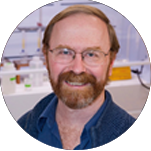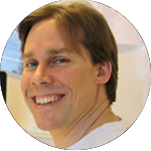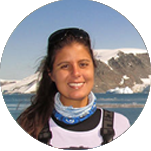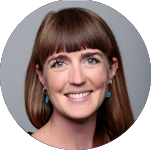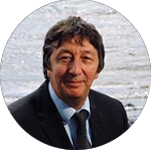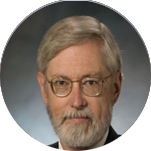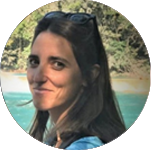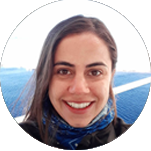Organizers
This side event is organized by the PICES-ICES working group 46 on ONCE and the UN Ocean Decade G-ONCE program. ONCE refers to ocean-based eco-engineering solutions for CO2 removal from the atmosphere and for the sustainable development of ecosystems and the society.
Organizing Partners

Background
With the 2030 Agenda for Sustainable Development and the Paris Climate Change Agreement adopted in 2015, the issue of securing mitigation and adaptation solutions to climate change became ever more central to both national and global agendas.
The ocean has the potential to store globally significant amounts of CO2, but approaches to enhance carbon sequestration require development and evaluation. Knowledge amongst countries for the realization of ocean-based carbon sequestration is still a long way from what is being considered.
G-ONCE undertakes and facilitates the science required to evaluate and implement eco-technological interventions, including learning from paleo-oceanic carbon processes to predict the future, restoring impacted marine ecosystems, fostering nature-based systems of land-sea integrated management, upwelling manipulation, microbial-driven comprehensive carbon sequestration, adjustment of nutrients, DO and pH.
Global ONCE is committed to 1) developing an international network of field stations and research facilities; 2) co-designing interdisciplinary collaborative research; 3) developing an evaluation framework for mitigation and adaptation approaches; 4) co-ordinating capacity building and 5) facilitating equitable policy, governance and societal understanding.
Key Issues discussed
● Ocean-based actions cover both mitigation and adaptation and range across four clusters (Decisive, Low Regret, Unproven, Risky) and ocean-based climate actions should be scaled-up by: 1) prioritizing Decisive and Low Regret; 2) improving knowledge on the Unproven measures; 3) cautiously weighing the Risky ones.
● To conduct the ocean-based innovative research, we need research facilities like Aquatron Tower Tank Facility Seabed, Marine Ecosystem Chamber System (MECS), Mini-MECS, the floating platform sea, seabed scientific observation subnetwork as well as marine ranching facilities.
● The mechanism for carbon sequestration in the ocean includes 1) Biological Carbon Pump (BCP), 2) Carbonate Counter Pump (CCP) and 3) Microbial Carbon Pump (MCP). MCP is different from the other two, because it can take place to any depth in the water column. What we need to do is to study the synergies between these three pumps since they are taking place at the same time in the real world. If we cannot control the boundary conditions, we could reach the maximum outputs of all these three pumps in forms of inorganic and organic carbon simultaneously for barrier in the sediment.
● Microbes are relevant not only as key players in biogeochemical cycles and food webs but also as climate regulators.
● Knowledge of microbial processes is required for evaluating, implementing and monitoring progressive approaches for ocean negative carbon emission.
● Ocean iron fertilization as an approach for atmospheric carbon dioxide removal. Studies show that natural iron are productive to sequester more carbon, but there is still a lot of research and development needed. Harmful algal blooms and things that were not observed in experiments that need to be studied other greenhouse gases that we measured that would offset some of the carbon dioxide, greenhouse gas drawdown.
● Adding alkalinity to the ocean can contribute to achieving negative carbon emissions: 1) Wastewater and coastal waters provide low pH, high pCO2 and organic acid rich sites for effective ALK addition; 2) Export of ALK modified water to the ocean may create an effective, safe and low-cost pathway for OAE and ONCE.
● Multiple assessments underway to inform governance of mCDR. Assessment itself is an act of governance – the selection and weighting of criteria depends on who is in the room. Diversifying types of knowledge involved in mCDR assessment process will produce more politically and societally relevant outputs.
Key recommendations for action
● International collaborative and interdisciplinary efforts (such as ONCE) are urgent.
● More innovative tools, integrated climate models, statistical techniques to link data and correlate disciplines are needed.
● Efforts to inform policies and educate the public needed to increase awareness and gather support.
● Lab and field experiments and regional and global scale models are needed to study the implementation of the strategy and its environmental and biological impact.
● Assessment to inform governance of mCDR approaches must address more than technical and environmental aspects – political and societal feasibility is critical.
● The next steps for Global ONCE are to develop a coordinated network of coastal and ocean study sites and experimental infrastructure available for collaborative experimental research relevant to carbon sequestration. Global ONCE will continue to co-design model and observational experiments including developing evaluation metrics and governance frameworks and promote capacity development and public outreach. We hoped to stimulate discussions that could lead to future collaborations and joint research projects as well as stimulate further information exchange to a range of scientific and societal audiences.
Voluntary Commitments
Global ONCE will undertake and facilitate science required to evaluate and implement eco-technological interventions, including learning from paleo-oceanic carbon processes to predict the future, restoring impacted marine ecosystems, fostering nature-based systems of land-sea integrated management, upwelling manipulation, microbial-driven comprehensive carbon sequestration, adjustment of nutrients, DO and pH. Global ONCE will 1) develop an international network of field stations and research facilities, 2) co-design interdisciplinary collaborative research, 3) develop an evaluation framework for mitigation and adaptation approaches, 4) co-ordinate capacity building and 5) facilitate equitable policy, governance and societal understanding.
Moderator, Speakers and Panellists Biography
lModerator
Prof. Carol Robinson | Professor of Marine Sciences within the School of Environmental Sciences at the University of East Anglia, U.K. Co-Chair of the International Council for the Exploration of the Sea (ICES) and the North Pacific Marine Science Organization (PICES) WG on Ocean Negative Carbon Emissions (ONCE) Chair of the Scientific Steering Committee of the SCOR/Future Earth Global Research Project ‘Integrated Marine Biosphere Research’ (IMBeR) |
lSpeakers
Prof. Nianzhi Jiao | Leading Scientist of Global ONCE Academician of Chinese Academy of Sciences (CAS) Academician of The World Academy of Sciences (TWAS) Academician of the American Academy of Microbiology Chair of the International Council for the Exploration of the Sea (ICES) and the North Pacific Marine Science Organization (PICES) International Joint Working Group on Negative Marine Emissions (WG46) |
| Senior scientist, Woods Hole Oceanographic Institution, USA Fellow AAAS, AGU, European Geochemical Society Foreign member of the Royal Netherlands Academy of Arts and Sciences Lead scientists, Exploring Ocean Iron Solutions Chief Scientist of the OIF program |
| Mary A. S. Lighthipe Chair Professor of Earth, Ocean and Environment, School of Marine Science and Policy, University of Delaware, Newark, Delaware, United States Fellow, American Geophysical Union (AGU) Fellow, American Association for the Advancement of Science (AAAS) Fellow, Geochemical Society (GS)-European Association of Geochemistry (EAG) Fellow, Association for the Sciences of Limnology and Oceanography (ASLO) |
Dr. David P. Keller | Senior Research Scientist and Coordinator of the OceanNETs project GEOMAR Helmholtz Centre for Ocean Research, Kiel, Germany |
Prof. Camila Negrão Signori | Professor at Oceanographic Institute, University of São Paulo, Brazil |
Dr. Jean-Pierre Gattuso | Fellow of the European Academy of Sciences Scientific Coordinator of the EPOCA (European Project on Ocean Acidification) Research Director of Sorbonne University, France |
Dr. Miranda Boettcher | Research Associate at the German Institute for International and Security Affairs (SWP), Berlin Affiliated member of the Environmental Governance Section at the Copernicus Institute of Sustainable Development, Utrecht University, Netherlands Member of the UN GESAMP Working Group 41 on Ocean Interventions for Climate Mitigation |
lPanellists
Dr. Douglas Wallace | Co-Chair of the ICES and PICES Working Group on ONCE Canada Excellence Research Chair in Ocean Science and Technology Dalhousie University, Canada |
Dr. Greg H. Rau | Senior researcher with the Institute of Marine Sciences, University of California, Santa Cru |
Dr. Lata Gawade | Assistant Professor of Microbiology, Goa University, India |
Dr. Celeste Lopez Abbate | Chief Scientist of Plankton Ecology Group Researcher of Argentine Institute of Oceanography, Argentina |
Ms. Raquel Flynn | PhD Student in Ocean and Atmospheric Science Department, University of Cape town, South Africa |
Side Event Recording
Recording of Ocean Negative Carbon Emissions and Sustainable Development Webinar on June 30, 2022
Contact Information
For any questions or comments please contact Ms. Mengqi Pei at meng.q.pei@gmail.com
Publications
Jiao N, Herndl GJ, Hansell DA, Benner R, Kattner G, Wilhelm SW, Kirchman DL, Weinbauer MG, Luo T & Chen F (2010) Microbial production of recalcitrant dissolved organic matter: long-term carbon storage in the global ocean. Nature Reviews Microbiology 8: 593-599.
Jiao N, Robinson C, Azam F, Thomas H, Baltar F, Dang H, Hardman-Mountford N, Johnson M, Kirchman D, Koch B, Legendre, L., Li, C., Liu, J., Luo, T., Luo, Y. W., Mitra, A., Romanou, A., Tang, K., Wang, X., Zhang, C. & Zhang, R. (2014) Mechanisms of microbial carbon sequestration in the ocean–future research directions. Biogeosciences 11: 5285-5306.
Jiao, N., J. Liu, B. Edwards, Z. Lv, R. Cai, Y. Liu, X. Xiao, J. Wang, F. Jiao, R. Wang, X. Huang, B. Guo, J. Sun, R. Zhang, Y. Zhang, K. Tang, Q. Zheng, F. Azam, J. Batt, W.-J. Cai, C. He, G. J. Herndl, P. Hill, D. Hutchins, J. LaRoche, M. Lewis, H. MacIntyre, L. Polimene, C. Robinson, Q. Shi, C. A. Suttle, H. Thomas, D. Wallace and L. Legendre (2021) Correcting a major error in assessing organic carbon pollution in natural waters. Science Advances 7: eabc7318.
Jiao N, Cai R, Zheng Q, Tang K, Liu J, Jiao F, Wallace D, Chen F, Li C & Amann R (2018) Unveiling the enigma of refractory carbon in the ocean. National Science Review 5: 459-463.
Jiao N, Tang K, Cai H & Mao Y (2011) Increasing the microbial carbon sink in the sea by reducing chemical fertilization on the land. Nature Reviews Microbiology 9: 75-75.
Bauer JE, Cai W-J, Raymond PA, Bianchi TS, Hopkinson CS & Regnier PA (2013) The changing carbon cycle of the coastal ocean. Nature 504: 61-70.
Boettcher M & Kim RE (2022) Arguments and architectures: Discursive and institutional structures shaping global climate engineering governance. Environmental Science & Policy 128: 121-131.
Boettcher M (2020) Coming to GRIPs with NETs discourse: implications of discursive structures for emerging governance of negative emissions technologies in the UK. Frontiers in climate 2: 595685.
Boettcher M (2020) Cracking the code: how discursive structures shape climate engineering research governance. Environmental politics 29: 890-916.
Boettcher M, Brent K, Buck HJ, Low S, McLaren D & Mengis N (2021) Navigating potential hype and opportunity in governing marine carbon removal. Frontiers in climate 3: 664456.
Boettcher M, Chai F, Cullen J, Goeschl T, Lampitt R, Lenton A, Oschlies A, Rau G, Rickaby R & Ricke K (2019) High level review of a wide range of proposed marine geoengineering techniques.
Cai W-J, Jiao N(2022) Wastewater alkalinity addition as a novel approach for ocean negative carbon emission, The Innovation., DOI: https://doi.org/10.1016/j.xinn.2022.100272.
Cai W-J (2011) Estuarine and coastal ocean carbon paradox: CO2 sinks or sites of terrestrial carbon incineration? Annual review of marine science 3: 123-145.
Cai W-J, Feely RA, Testa JM, Li M, Evans W, Alin SR, Xu Y-Y, Pelletier G, Ahmed A & Greeley DJ (2021) Natural and anthropogenic drivers of acidification in large estuaries. Annual Review of Marine Science 13.
Cai W-J, Hu X, Huang W-J, Murrell MC, Lehrter JC, Lohrenz SE, Chou W-C, Zhai W, Hollibaugh JT & Wang Y (2011) Acidification of subsurface coastal waters enhanced by eutrophication. Nature geoscience 4: 766-770.
Cai W-J, Huang W-J, Luther GW, Pierrot D, Li M, Testa J, Xue M, Joesoef A, Mann R & Brodeur J (2017) Redox reactions and weak buffering capacity lead to acidification in the Chesapeake Bay. Nature Communications 8: 1-12.
Cai W-J, Xu Y-Y, Feely RA, Wanninkhof R, Jönsson B, Alin SR, Barbero L, Cross JN, Azetsu-Scott K & Fassbender AJ (2020) Controls on surface water carbonate chemistry along North American ocean margins. Nature communications 11: 1-13.
Caldeira K & Rau GH (2000) Accelerating carbonate dissolution to sequester carbon dioxide in the ocean: Geochemical implications. Geophysical Research Letters 27: 225-228.
Cox E, Boettcher M, Spence E & Bellamy R (2021) Casting a wider net on ocean NETs. Frontiers in climate 3: 576294.
Flynn RF, Bornman TG, Burger JM, Smith S, Spence KA & Fawcett SE (2021) Summertime productivity and carbon export potential in the Weddell Sea, with a focus on the waters adjacent to Larsen C Ice Shelf. Biogeosciences 18: 6031-6059.
Flynn RF, Burger JM, Pillay K & Fawcett SE (2018) Wintertime rates of net primary production and nitrate and ammonium uptake in the southern Benguela upwelling system. African Journal of Marine Science 40: 253-266.
Gattuso J.-P., Jiao N., Chen F., Jouzel J., Le Quéré C., Lu Y., Tréguer P., von Schuckmann K., Wang Z. L. & Zang J. (2022) Ocean-based climate action. 12 p. Chinese Academy of Sciences and European Academy of Sciences. DOI: 10.5281/zenodo.6410659
Gattuso J-P, Magnan AK, Bopp L, et al. (2018) Ocean Solutions to Address Climate Change and Its Effects on Marine Ecosystems. Frontiers in Marine Science 5.
Gattuso J-P, Williamson P, Duarte CM & Magnan AK (2021) The Potential for Ocean-Based Climate Action: Negative Emissions Technologies and Beyond. Frontiers in Climate 2.
Gawade L, Barbuddhe S & Bhosle S (2010) Isolation and confirmation of Listeria species from seafood off Goa region by polymerase chain reaction. Indian journal of microbiology 50: 385-389.
Gawade L, Krishna M, Sarma V, Hemalatha K & Rao YV (2018) Spatio-temporal variability in the sources of particulate organic carbon and nitrogen in a tropical Godavari estuary. Estuarine, Coastal and Shelf Science 215: 20-29.
Gawade L, Sarma V, Rao YV & Hemalatha K (2017) Variation of bacterial metabolic rates and organic matter in the monsoon-affected tropical estuary (Godavari, India). Geomicrobiology Journal 34: 628-640.
Hays GC, Richardson AJ & Robinson C (2005) Climate change and marine plankton. Trends in Ecology & Evolution 20: 337-344.
Henley, S. F., E. L. Cavan, S. E. Fawcett, R. Kerr, T. Monteiro, R. M. Sherrell, A. R. Bowie, P. W. Boyd, D. K. A. Barnes, I. R. Schloss, T. Marshall, R. Flynn and S. Smith (2020).Changing Biogeochemistry of the Southern Ocean and Its Ecosystem Implications.Frontiers in Marine Science 7.
Keller D. P, Feng EY & Oschlies A (2014) Potential climate engineering effectiveness and side effects during a high carbon dioxide-emission scenario. Nature Communications 5: 3304
Keller D. P, Lenton A, Littleton EW, Oschlies A, Scott V & Vaughan NE (2018) The effects of carbon dioxide removal on the carbon cycle. Current climate change reports 4: 250-265.
Keller, D. P., A. Lenton, V. Scott, N. E. Vaughan, N. Bauer, D. Ji, C. D. Jones, B. Kravitz, H. Muri and K. Zickfeld (2018).The carbon dioxide removal model intercomparison project (CDRMIP): Rationale and experimental protocol for CMIP6.Geoscientific Model Development 11(3): 1133-1160.
Keller, D. P., I. Kriest, W. Koeve and A. Oschlies (2016). Southern Ocean biological impacts on global ocean oxygen.Geophysical Research Letters 43(12): 6469-6477.
Laruelle GG, Cai W-J, Hu X, Gruber N, Mackenzie FT & Regnier P (2018) Continental shelves as a variable but increasing global sink for atmospheric carbon dioxide. Nature communications 9: 1-11.
López-Abbate MC (2021) Microzooplankton communities in a changing ocean: A risk assessment. Diversity 13: 82.
López-Abbate MC, Molinero JC, Guinder VA, Perillo GM, Freije RH, Sommer U, Spetter CV & Marcovecchio JE (2017) Time-varying environmental control of phytoplankton in a changing estuarine system. Science of the Total Environment 609: 1390-1400.
López-Abbate MC, Molinero JC, Guinder VA, Dutto MS, de Cao MSB, Etcheverry LAR, Pettigrosso RE, Carcedo MC & Hoffmeyer MS (2015) Microplankton dynamics under heavy anthropogenic pressure. The case of the Bahía Blanca Estuary, southwestern Atlantic Ocean. Marine Pollution Bulletin 95: 305-314.
Low S & Boettcher M (2020) Delaying decarbonization: Climate governmentalities and sociotechnical strategies from Copenhagen to Paris. Earth system governance 5: 100073.
Montserrat F, Guilhon M, Corrêa PVF, Bergo NM, Signori CN, Tura PM, de los Santos Maly M, Moura D, Jovane L & Pellizari V (2019) Deep-sea mining on the Rio Grande Rise (Southwestern Atlantic): A review on environmental baseline, ecosystem services and potential impacts. Deep Sea Research Part I: Oceanographic Research Papers 145: 31-58.
Puccinelli, E., F. Porri, K. Altieri, R. Flynn, H. Little, T. Louw, P. Pattrick, C. Sparks, M. Tsanwani and S. de Waardt (2022).Coastal ecosystem services in South Africa’s largest natural bay: The role of marine benthic filter feeders in mitigating pollution.Ecological Indicators 139: 108899.
Raimondi, L., J. B. R. Matthews, D. Atamanchuk, K. Azetsu-Scott and D. W. Wallace (2019). The internal consistency of the marine carbon dioxide system for high latitude shipboard and in situ monitoring.Marine Chemistry 213: 49-70.
Rau GH & Caldeira K (1999) Enhanced carbonate dissolution:: a means of sequestering waste CO2 as ocean bicarbonate. Energy Conversion and Management 40: 1803-1813.
Rau GH (2008) Electrochemical splitting of calcium carbonate to increase solution alkalinity: Implications for mitigation of carbon dioxide and ocean acidity. Environmental science & technology 42: 8935-8940.
Rau GH (2011) CO2 mitigation via capture and chemical conversion in seawater. Environmental Science & Technology 45: 1088-1092.
Rau GH, McLeod EL & Hoegh-Guldberg O (2012) The need for new ocean conservation strategies in a high-carbon dioxide world. Nature climate change 2: 720-724.
Rau GH, Takahashi T & Marais DJD (1989) Latitudinal variations in plankton δ13C: implications for CO2 and productivity in past oceans. Nature 341: 516-518.
Rau GH, Willauer HD & Ren ZJ (2018) The global potential for converting renewable electricity to negative-CO2-emissions hydrogen. Nature Climate Change 8: 621-625.
Robinson C, Wallace D, Hyun J-H, Polimene L, Benner R, Zhang Y, Cai R, Zhang R & Jiao N (2018) An implementation strategy to quantify the marine microbial carbon pump and its sensitivity to global change. National Science Review 5: 474-480.
Robinson, C. (2019). Microbial respiration, the engine of ocean deoxygenation.Frontiers in Marine Science 5: 533.
Robinson, C., D. K. Steinberg, T. R. Anderson, J. Aristegui, C. A. Carlson, J. R. Frost, J.-F. Ghiglione, S. Hernandez-Leon, G. A. Jackson and R. Koppelmann (2010). Mesopelagic zone ecology and biogeochemistry–a synthesis. Deep Sea Research Part II: Topical Studies in Oceanography 57(16): 1504-1518.
Sabine CL, Feely RA, Gruber N, Key RM, Lee K, Bullister JL, Wanninkhof R, Wong C, Wallace DW & Tilbrook B (2004) The oceanic sink for anthropogenic CO2. science 305: 367-371.
Signori CN, de Sá Felizardo JP & Enrich-Prast A (2020) Bacterial production prevails over photo-and chemosynthesis in a eutrophic tropical lagoon. Estuarine, Coastal and Shelf Science 243: 106889.
Signori CN, Lima AOdS, Nakayama CR & Pellizari VH (2020) Deep-Sea Microbes in the Southwestern Atlantic. Brazilian Deep-Sea Biodiversity,p.^pp. 133-151. Springer.
Tanhua T, Körtzinger A, Friis K, Waugh DW & Wallace DW (2007) An estimate of anthropogenic CO2 inventory from decadal changes in oceanic carbon content. Proceedings of the National Academy of Sciences 104: 3037-3042.
Tonelli M, Signori CN, Bendia A, Neiva J, Ferrero B, Pellizari V & Wainer I (2021) Climate projections for the Southern Ocean reveal impacts in the marine microbial communities following increases in sea surface temperature. Frontiers in Marine Science 8: 502.
Venkataramana V, Sarma V, Gawade L & Reddy AM (2021) Magnitude of river discharge determines the food habit and community composition of zooplankton in the Indian estuaries during monsoon. Estuarine, Coastal and Shelf Science 262: 107601.
Wallace, D. W. (2001). Ocean measurements and models of carbon sources and sinks.Global Biogeochemical Cycles 15(1): 3-10.


